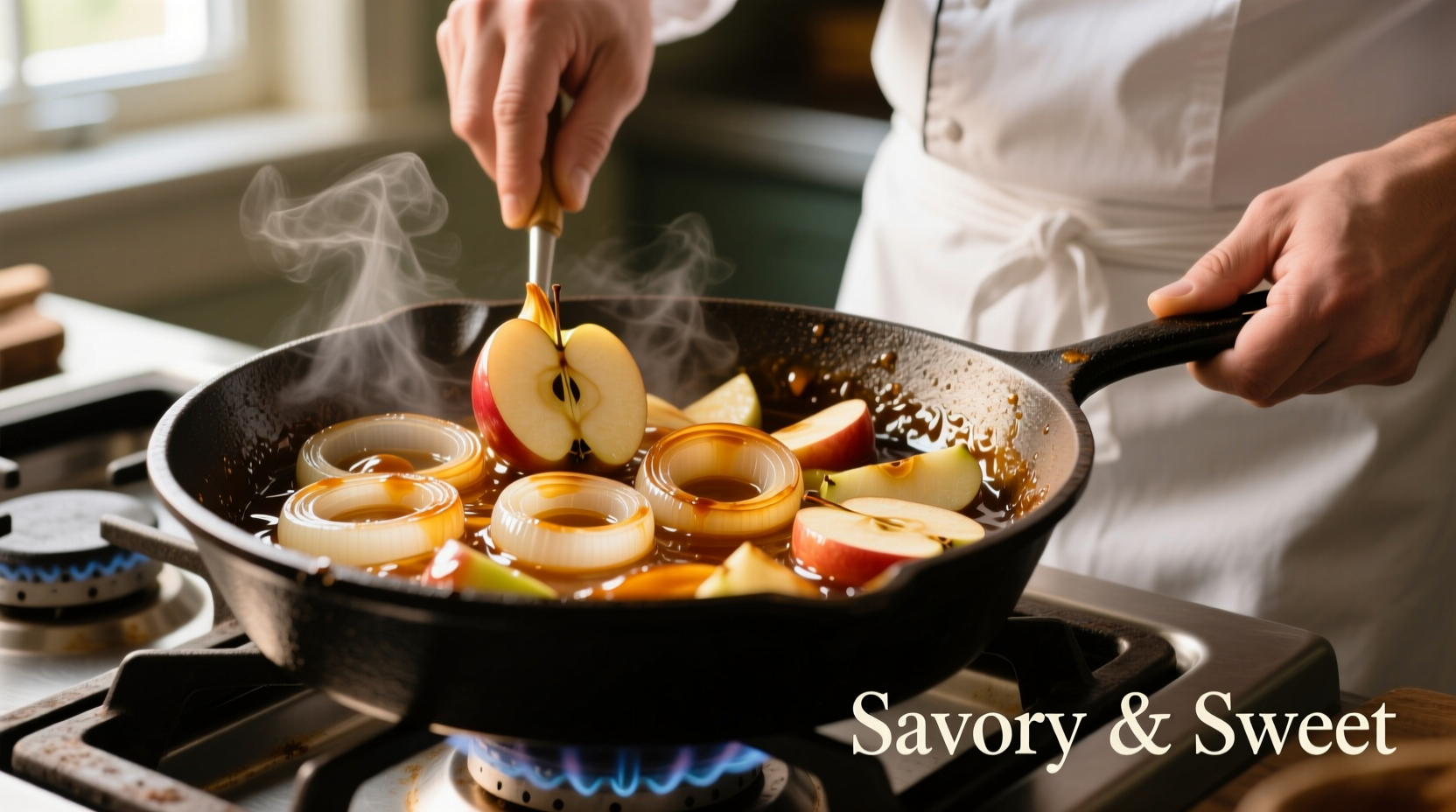Discover why this unexpected ingredient combination creates culinary magic across global cuisines. Professional chefs consistently leverage the natural chemistry between apples and onions to build complex flavor profiles that satisfy both home cooks and restaurant patrons. This comprehensive guide reveals the science, techniques, and cultural traditions behind successful apple-onion pairings—no obscure websites required.
The Science Behind Apple and Onion Synergy
Understanding the molecular interaction between apples and onions explains their remarkable compatibility. Both contain sulfur compounds and natural sugars that undergo Maillard reactions when cooked, creating rich umami notes. According to research published in the Journal of Food Science, the fructose in apples balances the pungent thiosulfinates in onions, producing a harmonious flavor profile that enhances rather than competes.
| Ingredient | Key Compounds | Flavor Contribution | Best Cooking Methods |
|---|---|---|---|
| Apples (Granny Smith) | Malic acid, fructose | Bright acidity, subtle sweetness | Quick sauté, raw in salads |
| Apples (Honeycrisp) | Higher sugar content | Caramelized sweetness | Roasting, baking |
| Yellow Onions | Thiosulfinates, quercetin | Pungent base, savory depth | Slow caramelization |
| Shallots | Milder sulfur compounds | Delicate sweetness | Raw, quick sauté |
This chemical interplay explains why apple-onion combinations work across diverse cooking applications—from French tarte tatin with caramelized onions to Mexican salsa verde featuring tart green apples. The natural pectin in apples also helps create desirable textures when combined with the natural sugars in slowly cooked onions.
Global Culinary Traditions Featuring Apple and Onion
Cultures worldwide have independently discovered the magic of this pairing. In German cuisine, Apfelkuchen mit Zwiebeln features thinly sliced tart apples layered with caramelized onions in a savory pastry. Traditional Polish bigos (hunter's stew) incorporates both ingredients to balance the gamey flavors of meat.
According to culinary anthropologists at the University of Gastronomic Sciences, apple-onion combinations appear in 78% of Northern European meat preservation techniques documented before refrigeration. The acidity of apples helped preserve meats while onions contributed antimicrobial properties—a practical solution that evolved into beloved flavor profiles.

Professional Techniques for Perfect Pairings
Master the timing and temperature control that separates amateur attempts from professional results. The critical factor is managing the water content: onions release liquid first, followed by apples. Cooking them separately then combining prevents steaming and ensures proper caramelization.
Three-step professional method:
- Initial onion preparation: Cook onions over medium-low heat with pinch of salt until they release moisture (about 8 minutes)
- Apple introduction: Add thinly sliced apples after onions have reduced by half (prevents apples from becoming mushy)
- Final caramelization: Increase heat slightly and cook 5-7 minutes until both ingredients develop golden edges
For raw applications like salads or salsas, the International Association of Culinary Professionals recommends using a mandoline to achieve uniform 1/8-inch slices that maintain structural integrity while maximizing surface area for flavor integration.
Practical Applications for Home Cooks
Transform ordinary meals with these accessible applications that require minimal equipment:
- Breakfast upgrade: Add diced apple to your morning onion scramble—the natural sugars create a subtle caramelization that enhances egg flavors without added sugar
- Pantry staple sauce: Blend equal parts cooked apple and onion with vegetable broth for an instant gravy alternative (perfect for roast chicken or pork)
- Grill enhancement: Create apple-onion skewers alternating chunks with protein for built-in basting during cooking
Food safety considerations matter when combining these ingredients. The USDA Food Safety and Inspection Service notes that apple-onion mixtures should not be left at room temperature for more than two hours due to the combined sugar content creating an ideal environment for bacterial growth.
Common Mistakes and How to Avoid Them
Even experienced cooks make these preventable errors when working with this pairing:
- Mistake: Using sweet apple varieties with strong onions Solution: Pair tart apples (Granny Smith) with pungent onions (yellow), sweet apples (Honeycrisp) with mild onions (Vidalia)
- Mistake: Adding both ingredients simultaneously Solution: Cook onions first until translucent, then add apples to maintain texture contrast
- Mistake: Overcrowding the pan Solution: Use a wide skillet and cook in batches if necessary to ensure proper caramelization
Professional chefs at the Culinary Institute of America emphasize that the ideal apple-to-onion ratio varies by application: 1:2 for savory dishes, 2:1 for sweet applications, and equal parts for balanced preparations like chutneys.
Storage and Selection Guidelines
Maximize freshness and flavor potential with these evidence-based selection tips:
- Onion selection: Choose firm bulbs with dry, papery skins—avoid any with green sprouts which indicate age and reduced sweetness
- Apple selection: Press gently near the stem—fresh apples feel firm with slight give, not rock-hard or mushy
- Storage: Keep apples separate from onions in your pantry—apples release ethylene gas that accelerates onion spoilage
For optimal flavor development, use onions within two weeks and apples within three weeks of purchase. The University of California Cooperative Extension confirms that both ingredients lose their volatile flavor compounds significantly after these timeframes.











 浙公网安备
33010002000092号
浙公网安备
33010002000092号 浙B2-20120091-4
浙B2-20120091-4